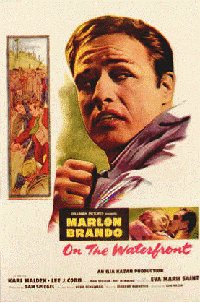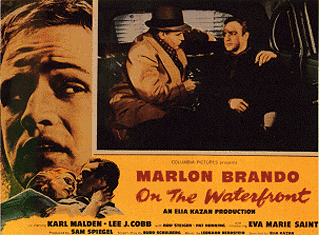On the Waterfront
Released April 1954 by Columbia with a budget of $910,000, gross of $9.6 million, black and white 35mm negative 1.37:1 screen ratio, mono sound, 108 mins., Laserdisc released 1994
Production:
- Directed by Elia Kazan
- Produced by Sam Spiegel for Horizon Pictures (founded 1947 with John Huston)
- Screenplay by Budd Schulberg; based on Malcolm Johnson's 1949 Pulitzer Prize-winning New York Sun series "Crime on the Labor Front" including the life of Rev. John Corridan, the "Waterfront Priest" and Arthur Miller's 1950 play "The Hook" about dock organizer Peter Panto in the 1930's
- Original music by Leonard Bernstein (Waterfront theme, Edie Love theme that announces her entrances, Murder theme, frequent Snap theme with complex metric beat and disturbing eighth-note pattern)
- Cinematography by Boris Kaufman
- Film Editing by Gene Milford
- Art Direction by Richard Day (showed city as foggy, oppressive, confining and threatening)
Cast:
- Marlon Brando as Terry Malloy
- Eva Marie Saint as Edie Doyle
- Karl Malden as Father Barry
- Lee J. Cobb as Johnny Friendly
- Rod Steiger as Charley Malloy
- Pat Henning as "KO" Dugan
- John Hamilton as Pop Doyle
- Martin Balsam as Gillette
- Fred Gwynne as Slim
- Leif Erickson as Glover
- James Westerfield as Big Mac
- Tony Galento as Truck
- Tami Mauriello as Tillio
- Arthur Keegan as Jimmy
- Don Blackman as Luke
- Abe Simon as Barney
Notes:
During the 1945 dock strike in New York by the ILA, the International Longshoremen's Association, leader William Warren "fell" and hurt himself and made a public "confession" that he had been tricked by the Communist Party. The New York Anti-Crime Commission met during the 1948 dock strike and subpoened mobster John Dunn on deathrow to name "Mr. Big" (possibly financier Big Bill McCormick or mayor William O'Dwyer) but the strike settled and Dunn shut up. The 1949 Pulitzer Prize was won by Malcolm Johnson for his New York Sun series "Crime on the Waterfront," about the dock strikes. In 1949 Arthur Miller wrote a play "The Bottom of the River" about the efforts of Peter Panto in the 1930s to organize the dock workers of the Brooklyn Red Hook district but was murdered by the mob. Miller rewrote the play in 1950 as a screenplay "The Hook" for Elia Kazan who wanted to make the film but it was rejected by studios. The 1951 televised hearings of Estes Kefauver Committee revealed mob leaders Frank Ryan and Frank Costello. The 1951 HUAC testimony by Budd Schulberg and the 1952 testimony by Kazan named names of former Hollywood communist party members. The November 1952 Crime Commission published findings that described many abuses and failures of the system; Kazan and Schulberg produced 8 script drafts over next 2 years that focused on drama and characters but not on the causes of the dock problems. Shortly after the film's debut in 1954, the AFL-CIO expelled the East Coast longshoremen's union because it was still run by the mob. In 1955 Schulberg wrote his novel "Waterfront" that focused on causes and involvement of the shipping companies, mayor's office, police, church. In 1955 Anthony "Tony Mike" de Vincenzo filed a lawsuit against Columbia because Terry's character seemed to have been based on him, and won a small out-of-court settlement. In 1979, ILA boss Michael Clemente (model for the film's Johnny Friendly) and other members of the Vito Genovese family were indicted for corruption and racketeering on the New York waterfront.
Narrative:
1. Techniques
- realism of New York docks mis-en-scene, the haggard faces of dockworkers, the bleak environment
- enclosed spaces vs. open spaces, fence blocks relationships
- camera up and down angles emphasize entrapment, points down during shapeup scramble but points up in the martyrdom scene
- laundry hanging on lines form diagonals that intrude on human space, alleyways with blinding lights, dark caverns and underground passages.
- Diffused lighting used to emphasize moral confusion, with Kazan producing smoke from trash fires and spraying mist and using fog
- Realism of Brando's "method" acting style, affective emotion based on his own feelings, most people are inarticulate and use body language
- Terry wants to be a loner; his habit of looking away from people to protect himself from them
- POV becomes subjective after truck almost hits Terry and Edie; at end camera shifts from social perspective to Terry's personal perspective, cloudy and blurry
2. Structure
- 3 parts punctuated with 3 deaths:
- Terry goes along with corruption revealed in the "shape-up" scene and helps set up the death of Joey Doyle
- Terry discovers depth of his corruption ending with death in ship's hold of Kayo Dugan and the "martyrdom" scene with Father Barry's sermon
- Terry is resurrected and fights back after death of Charlie and confesses in the "testimonial" scene.
3. Themes
- moral struggle of Terry
- Terry's complex character, as boxer and pigeon-keeper, tough yet sensitive, vain and loving, proud and vulnerable, independent and dependent
- Edie's white glove in park brings them together, replacing the boxing gloves he used to wear; spiritual vs. physical
- Christian symbols, Father Barry's sermon with shadow of cross, Terry's jacket worn by previous martyrs, bleeds about the head from his beating at end, carries the longshoreman's hook as a cross, leads the flock back to work
Links:


